Lifelong Learning: Strategies, Barriers, and School Preparation
VerifiedAdded on 2020/05/16
|14
|3639
|115
Report
AI Summary
This report delves into the multifaceted concept of lifelong learning, emphasizing its increasing importance due to factors such as increased life expectancy and the need for continuous skill development. It explores various strategies for engaging in lifelong learning, including reading widely, seeking diverse perspectives, and making learning a priority. The report also examines the crucial role of schools in preparing young learners to embrace lifelong learning by nurturing curiosity, promoting problem-solving abilities, encouraging creativity, and fostering an understanding that learning is a continuous process. Furthermore, it identifies the challenges and barriers to lifelong learning, such as time constraints and access to resources, while highlighting the benefits of lifelong learning in both personal and professional contexts. The report concludes by underscoring the significance of lifelong learning for individual development, employability, and active citizenship in a rapidly changing world.

Running head: COMMUNICATION AND LEARNING
Communication and Learning
Name of Student:
Name of University:
Author’s Note:
Communication and Learning
Name of Student:
Name of University:
Author’s Note:
Paraphrase This Document
Need a fresh take? Get an instant paraphrase of this document with our AI Paraphraser
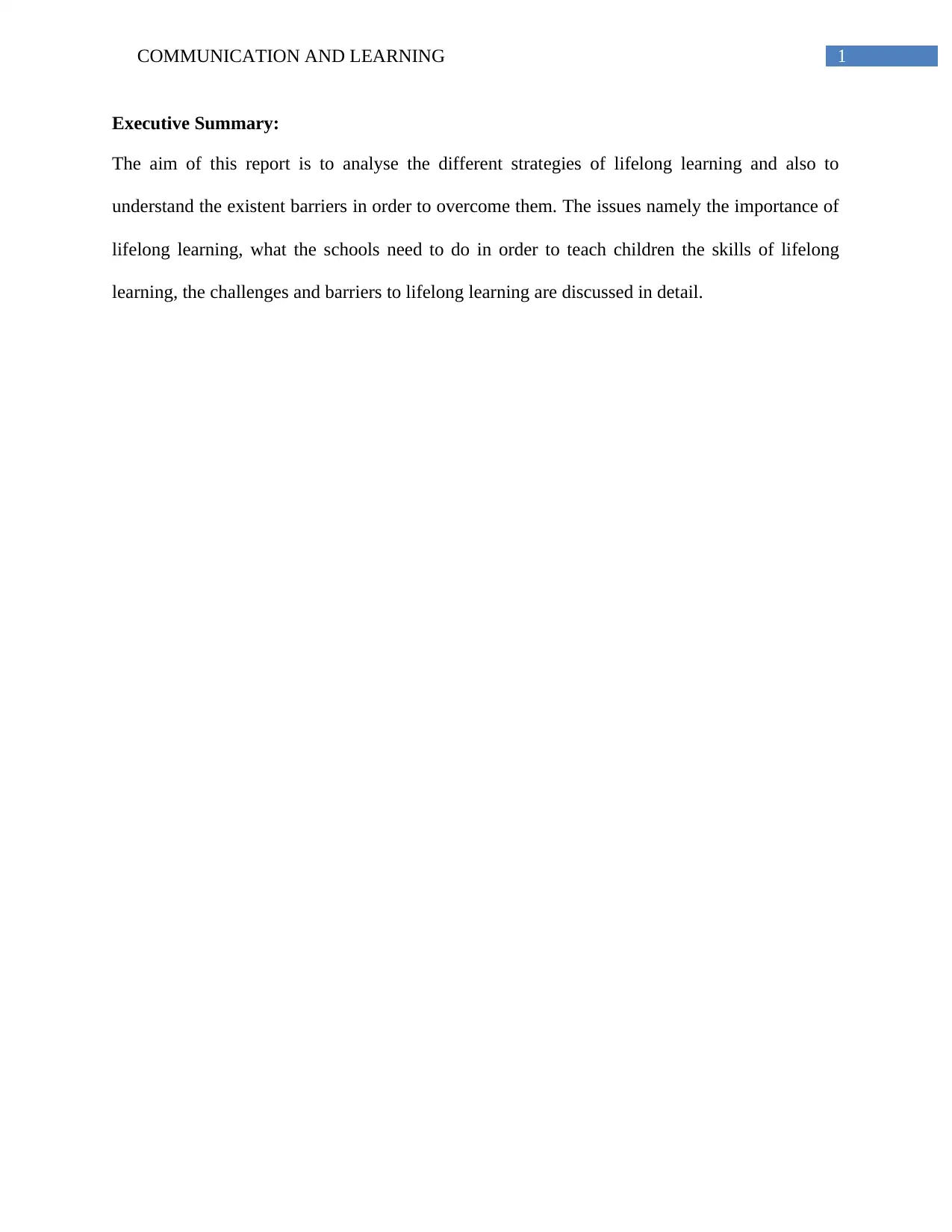
1COMMUNICATION AND LEARNING
Executive Summary:
The aim of this report is to analyse the different strategies of lifelong learning and also to
understand the existent barriers in order to overcome them. The issues namely the importance of
lifelong learning, what the schools need to do in order to teach children the skills of lifelong
learning, the challenges and barriers to lifelong learning are discussed in detail.
Executive Summary:
The aim of this report is to analyse the different strategies of lifelong learning and also to
understand the existent barriers in order to overcome them. The issues namely the importance of
lifelong learning, what the schools need to do in order to teach children the skills of lifelong
learning, the challenges and barriers to lifelong learning are discussed in detail.

2COMMUNICATION AND LEARNING
Table of Contents
Introduction:....................................................................................................................................3
Importance of Lifelong learning:.....................................................................................................3
Different ways of engaging in lifelong learning:.............................................................................5
What the schools need to do to prepare young learners to be lifelong learners:.............................6
What are the challenges faced in lifelong learning:.........................................................................9
Conclusion:....................................................................................................................................11
References:....................................................................................................................................12
Table of Contents
Introduction:....................................................................................................................................3
Importance of Lifelong learning:.....................................................................................................3
Different ways of engaging in lifelong learning:.............................................................................5
What the schools need to do to prepare young learners to be lifelong learners:.............................6
What are the challenges faced in lifelong learning:.........................................................................9
Conclusion:....................................................................................................................................11
References:....................................................................................................................................12
⊘ This is a preview!⊘
Do you want full access?
Subscribe today to unlock all pages.

Trusted by 1+ million students worldwide
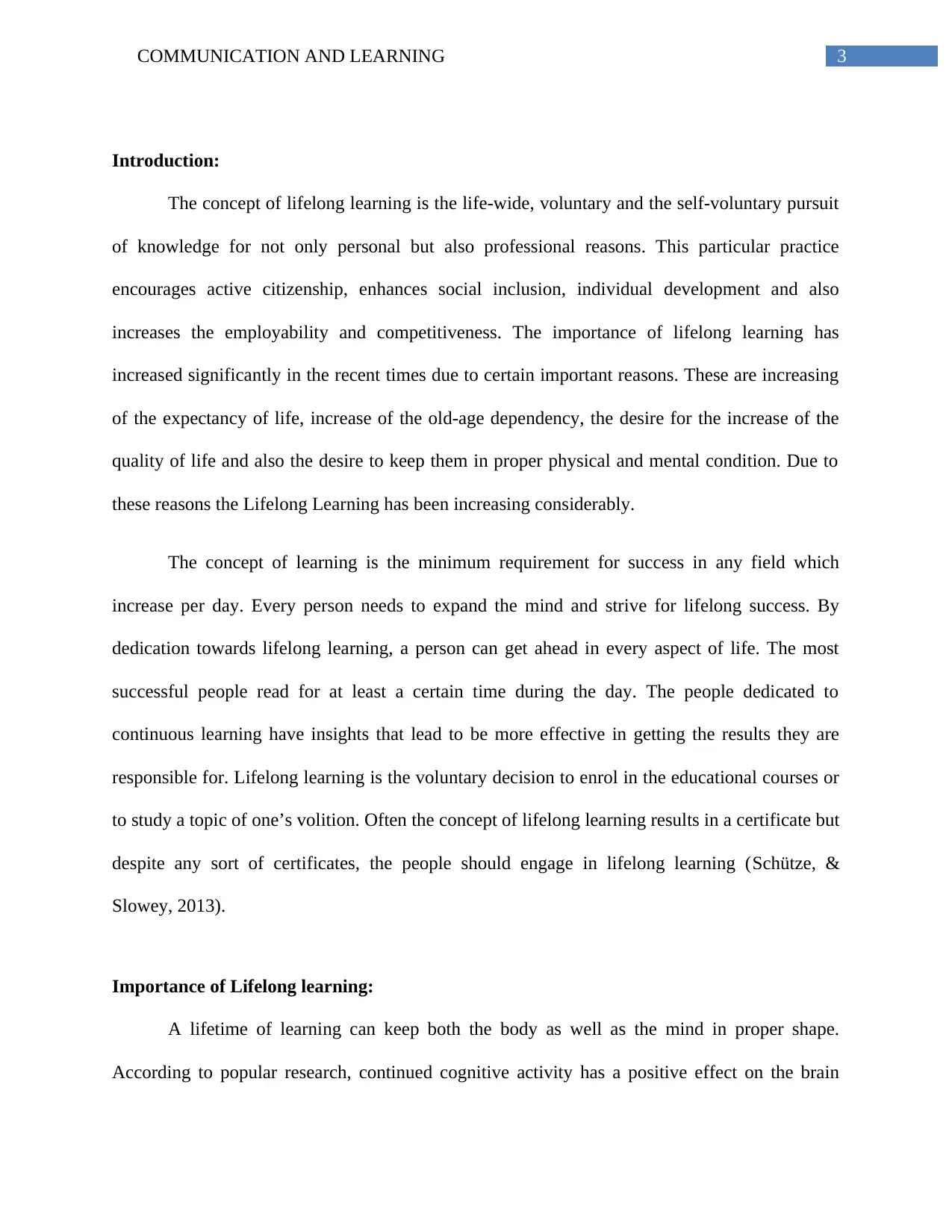
3COMMUNICATION AND LEARNING
Introduction:
The concept of lifelong learning is the life-wide, voluntary and the self-voluntary pursuit
of knowledge for not only personal but also professional reasons. This particular practice
encourages active citizenship, enhances social inclusion, individual development and also
increases the employability and competitiveness. The importance of lifelong learning has
increased significantly in the recent times due to certain important reasons. These are increasing
of the expectancy of life, increase of the old-age dependency, the desire for the increase of the
quality of life and also the desire to keep them in proper physical and mental condition. Due to
these reasons the Lifelong Learning has been increasing considerably.
The concept of learning is the minimum requirement for success in any field which
increase per day. Every person needs to expand the mind and strive for lifelong success. By
dedication towards lifelong learning, a person can get ahead in every aspect of life. The most
successful people read for at least a certain time during the day. The people dedicated to
continuous learning have insights that lead to be more effective in getting the results they are
responsible for. Lifelong learning is the voluntary decision to enrol in the educational courses or
to study a topic of one’s volition. Often the concept of lifelong learning results in a certificate but
despite any sort of certificates, the people should engage in lifelong learning (Schütze, &
Slowey, 2013).
Importance of Lifelong learning:
A lifetime of learning can keep both the body as well as the mind in proper shape.
According to popular research, continued cognitive activity has a positive effect on the brain
Introduction:
The concept of lifelong learning is the life-wide, voluntary and the self-voluntary pursuit
of knowledge for not only personal but also professional reasons. This particular practice
encourages active citizenship, enhances social inclusion, individual development and also
increases the employability and competitiveness. The importance of lifelong learning has
increased significantly in the recent times due to certain important reasons. These are increasing
of the expectancy of life, increase of the old-age dependency, the desire for the increase of the
quality of life and also the desire to keep them in proper physical and mental condition. Due to
these reasons the Lifelong Learning has been increasing considerably.
The concept of learning is the minimum requirement for success in any field which
increase per day. Every person needs to expand the mind and strive for lifelong success. By
dedication towards lifelong learning, a person can get ahead in every aspect of life. The most
successful people read for at least a certain time during the day. The people dedicated to
continuous learning have insights that lead to be more effective in getting the results they are
responsible for. Lifelong learning is the voluntary decision to enrol in the educational courses or
to study a topic of one’s volition. Often the concept of lifelong learning results in a certificate but
despite any sort of certificates, the people should engage in lifelong learning (Schütze, &
Slowey, 2013).
Importance of Lifelong learning:
A lifetime of learning can keep both the body as well as the mind in proper shape.
According to popular research, continued cognitive activity has a positive effect on the brain
Paraphrase This Document
Need a fresh take? Get an instant paraphrase of this document with our AI Paraphraser
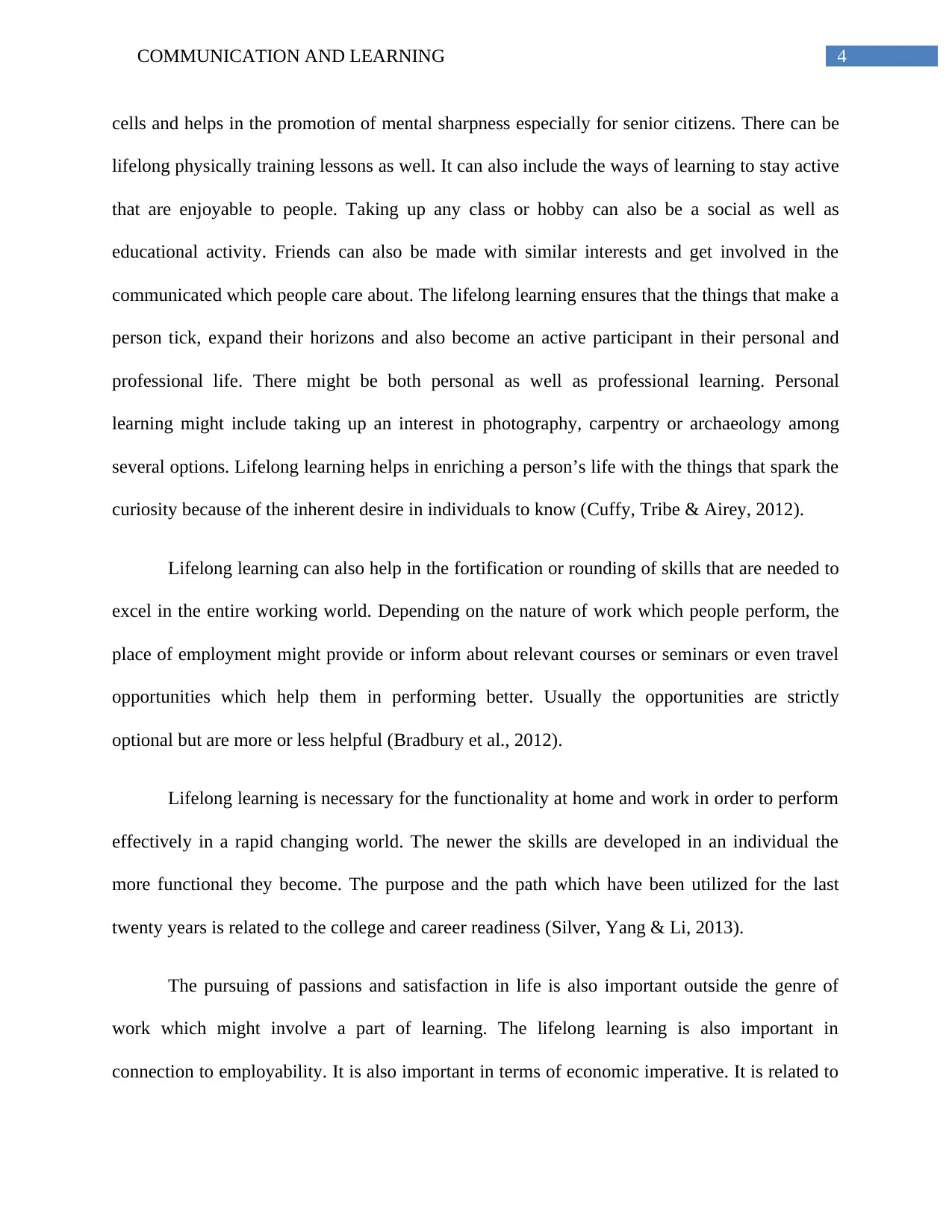
4COMMUNICATION AND LEARNING
cells and helps in the promotion of mental sharpness especially for senior citizens. There can be
lifelong physically training lessons as well. It can also include the ways of learning to stay active
that are enjoyable to people. Taking up any class or hobby can also be a social as well as
educational activity. Friends can also be made with similar interests and get involved in the
communicated which people care about. The lifelong learning ensures that the things that make a
person tick, expand their horizons and also become an active participant in their personal and
professional life. There might be both personal as well as professional learning. Personal
learning might include taking up an interest in photography, carpentry or archaeology among
several options. Lifelong learning helps in enriching a person’s life with the things that spark the
curiosity because of the inherent desire in individuals to know (Cuffy, Tribe & Airey, 2012).
Lifelong learning can also help in the fortification or rounding of skills that are needed to
excel in the entire working world. Depending on the nature of work which people perform, the
place of employment might provide or inform about relevant courses or seminars or even travel
opportunities which help them in performing better. Usually the opportunities are strictly
optional but are more or less helpful (Bradbury et al., 2012).
Lifelong learning is necessary for the functionality at home and work in order to perform
effectively in a rapid changing world. The newer the skills are developed in an individual the
more functional they become. The purpose and the path which have been utilized for the last
twenty years is related to the college and career readiness (Silver, Yang & Li, 2013).
The pursuing of passions and satisfaction in life is also important outside the genre of
work which might involve a part of learning. The lifelong learning is also important in
connection to employability. It is also important in terms of economic imperative. It is related to
cells and helps in the promotion of mental sharpness especially for senior citizens. There can be
lifelong physically training lessons as well. It can also include the ways of learning to stay active
that are enjoyable to people. Taking up any class or hobby can also be a social as well as
educational activity. Friends can also be made with similar interests and get involved in the
communicated which people care about. The lifelong learning ensures that the things that make a
person tick, expand their horizons and also become an active participant in their personal and
professional life. There might be both personal as well as professional learning. Personal
learning might include taking up an interest in photography, carpentry or archaeology among
several options. Lifelong learning helps in enriching a person’s life with the things that spark the
curiosity because of the inherent desire in individuals to know (Cuffy, Tribe & Airey, 2012).
Lifelong learning can also help in the fortification or rounding of skills that are needed to
excel in the entire working world. Depending on the nature of work which people perform, the
place of employment might provide or inform about relevant courses or seminars or even travel
opportunities which help them in performing better. Usually the opportunities are strictly
optional but are more or less helpful (Bradbury et al., 2012).
Lifelong learning is necessary for the functionality at home and work in order to perform
effectively in a rapid changing world. The newer the skills are developed in an individual the
more functional they become. The purpose and the path which have been utilized for the last
twenty years is related to the college and career readiness (Silver, Yang & Li, 2013).
The pursuing of passions and satisfaction in life is also important outside the genre of
work which might involve a part of learning. The lifelong learning is also important in
connection to employability. It is also important in terms of economic imperative. It is related to
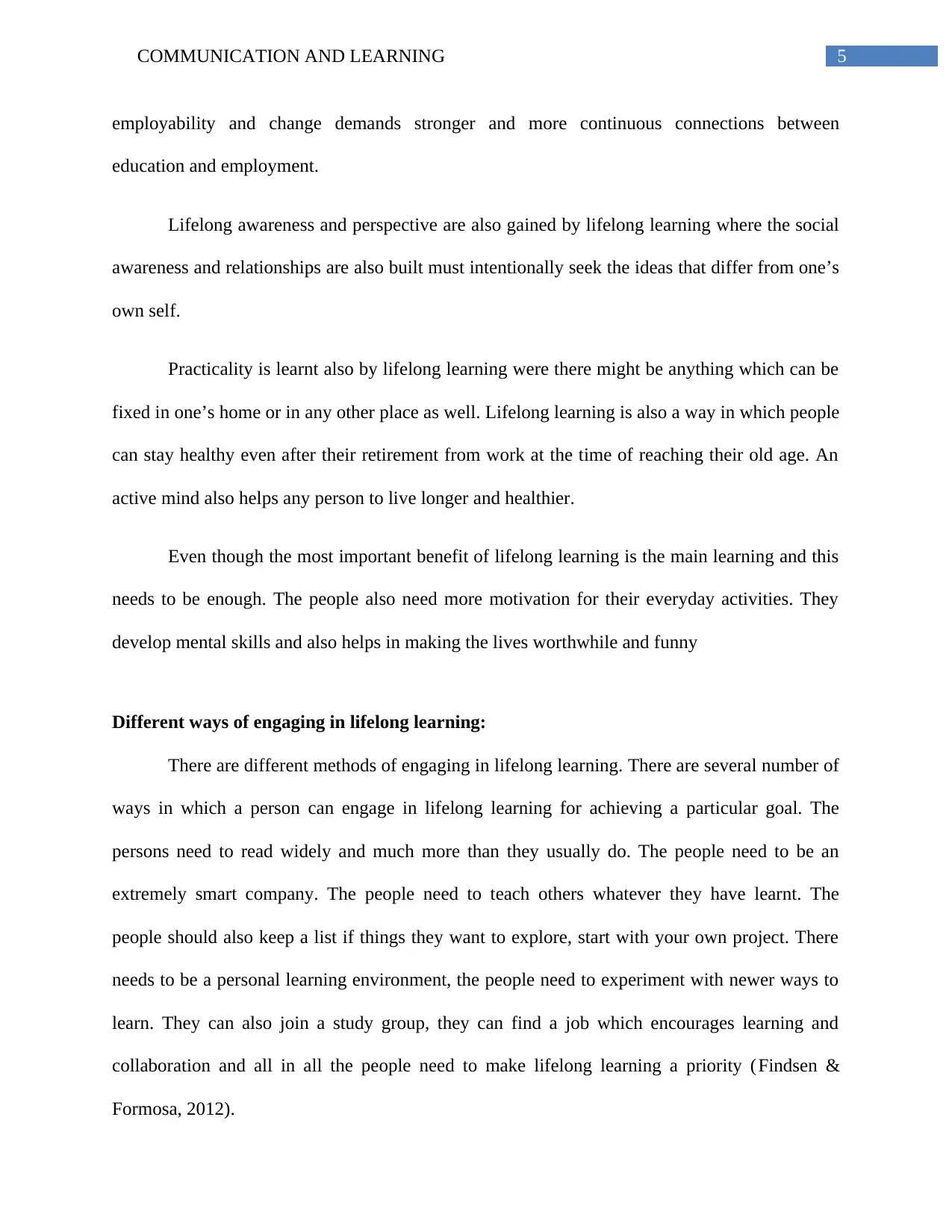
5COMMUNICATION AND LEARNING
employability and change demands stronger and more continuous connections between
education and employment.
Lifelong awareness and perspective are also gained by lifelong learning where the social
awareness and relationships are also built must intentionally seek the ideas that differ from one’s
own self.
Practicality is learnt also by lifelong learning were there might be anything which can be
fixed in one’s home or in any other place as well. Lifelong learning is also a way in which people
can stay healthy even after their retirement from work at the time of reaching their old age. An
active mind also helps any person to live longer and healthier.
Even though the most important benefit of lifelong learning is the main learning and this
needs to be enough. The people also need more motivation for their everyday activities. They
develop mental skills and also helps in making the lives worthwhile and funny
Different ways of engaging in lifelong learning:
There are different methods of engaging in lifelong learning. There are several number of
ways in which a person can engage in lifelong learning for achieving a particular goal. The
persons need to read widely and much more than they usually do. The people need to be an
extremely smart company. The people need to teach others whatever they have learnt. The
people should also keep a list if things they want to explore, start with your own project. There
needs to be a personal learning environment, the people need to experiment with newer ways to
learn. They can also join a study group, they can find a job which encourages learning and
collaboration and all in all the people need to make lifelong learning a priority (Findsen &
Formosa, 2012).
employability and change demands stronger and more continuous connections between
education and employment.
Lifelong awareness and perspective are also gained by lifelong learning where the social
awareness and relationships are also built must intentionally seek the ideas that differ from one’s
own self.
Practicality is learnt also by lifelong learning were there might be anything which can be
fixed in one’s home or in any other place as well. Lifelong learning is also a way in which people
can stay healthy even after their retirement from work at the time of reaching their old age. An
active mind also helps any person to live longer and healthier.
Even though the most important benefit of lifelong learning is the main learning and this
needs to be enough. The people also need more motivation for their everyday activities. They
develop mental skills and also helps in making the lives worthwhile and funny
Different ways of engaging in lifelong learning:
There are different methods of engaging in lifelong learning. There are several number of
ways in which a person can engage in lifelong learning for achieving a particular goal. The
persons need to read widely and much more than they usually do. The people need to be an
extremely smart company. The people need to teach others whatever they have learnt. The
people should also keep a list if things they want to explore, start with your own project. There
needs to be a personal learning environment, the people need to experiment with newer ways to
learn. They can also join a study group, they can find a job which encourages learning and
collaboration and all in all the people need to make lifelong learning a priority (Findsen &
Formosa, 2012).
⊘ This is a preview!⊘
Do you want full access?
Subscribe today to unlock all pages.

Trusted by 1+ million students worldwide

6COMMUNICATION AND LEARNING
Learning aims to help people reach the full potential and help them achieve self
actualization. The highest need is identified by utilizing the hierarchy of needs. The lifelong
learning preserves an individual’s desire to obtain new knowledge outside the formal education
system. Development of an attitude where a person can constantly learn is the only way in which
the people can succeed in the dynamic environment. There is so much of technology at the
fingertips where a person can take advantage and help them learn throughout their life. This
means that the person needs to follow the passion for languages, improve the skills of craft and
also develop a mobile application using the resources which can be found.
Learning should also be made into a priority. This is because of the reason that in case the
people learn on a day to day basis, they can improve in their daily lives. In case the people are
engaged in their job, it also encourages learning and collaboration.
The people can buy newspapers, search for things online that they want to know about,
ask their friends for books which they find helpful and also be curious. In case a topic is obtained
on which much of information is not available sufficient research can be made on the topic. The
people also need to keep connection with the contacts which they admire. They should also keep
contact with people who have provided inspiration to them on the journey.
The people might also find newer study groups to collaborate and learn from people.
There can be a collaboration from a variety of sources and apply it to the search of knowledge.
What the schools need to do to prepare young learners to be lifelong learners:
It is beneficial in case every child is prepared to be a lifelong learner. In case certain
characteristics are imbibed in the children from a very young age, they can continue these habits
Learning aims to help people reach the full potential and help them achieve self
actualization. The highest need is identified by utilizing the hierarchy of needs. The lifelong
learning preserves an individual’s desire to obtain new knowledge outside the formal education
system. Development of an attitude where a person can constantly learn is the only way in which
the people can succeed in the dynamic environment. There is so much of technology at the
fingertips where a person can take advantage and help them learn throughout their life. This
means that the person needs to follow the passion for languages, improve the skills of craft and
also develop a mobile application using the resources which can be found.
Learning should also be made into a priority. This is because of the reason that in case the
people learn on a day to day basis, they can improve in their daily lives. In case the people are
engaged in their job, it also encourages learning and collaboration.
The people can buy newspapers, search for things online that they want to know about,
ask their friends for books which they find helpful and also be curious. In case a topic is obtained
on which much of information is not available sufficient research can be made on the topic. The
people also need to keep connection with the contacts which they admire. They should also keep
contact with people who have provided inspiration to them on the journey.
The people might also find newer study groups to collaborate and learn from people.
There can be a collaboration from a variety of sources and apply it to the search of knowledge.
What the schools need to do to prepare young learners to be lifelong learners:
It is beneficial in case every child is prepared to be a lifelong learner. In case certain
characteristics are imbibed in the children from a very young age, they can continue these habits
Paraphrase This Document
Need a fresh take? Get an instant paraphrase of this document with our AI Paraphraser

7COMMUNICATION AND LEARNING
for the rest of their lives in future as well. The schools of the young learners should take up the
responsibility of training them to be lifelong learners.
The people at all ages need to be curious at all times. Therefore the schools need to
encourage curiosity at all times. Even the babies explore by crawling, putting things in their
mouths and also by knocking things over. The young children learn by asking necessary
questions and by taking things apart. Older kids continue to hone their knowledge as they
develop a sort of passion for a topic or a theme. They need to nurture their curiosity at all
possible age groups (Aspin et al., 2012).
Problem solving abilities also need to be inculcated from a young age. The kids need to
be given challenges and opportunities which challenge their mind. It should be left on the
students to decide which strategy they will use to solve their everyday problems. They need to be
given choices instead of suggestions. They need to be able to make their own decisions from a
very young age. They need to be given choices instead of decisions. In case the children can take
their responsibilities from a very young age they will be accountable for their decisions
(Jimoyiannis & Gravani, 2012).
There needs to be a promotion of problem-solving capabilities from very early on in life.
It is necessary to give them opportunities and provide them with ample questions to challenge
their minds. They need to be given the liberty to choose which strategy they need to use. They
should not be provided with any decisions.
Children need to be taught creativity from a very young age. They need to be encouraged
to approach art in a proper way. They need to be allowed to use their imagination and think
for the rest of their lives in future as well. The schools of the young learners should take up the
responsibility of training them to be lifelong learners.
The people at all ages need to be curious at all times. Therefore the schools need to
encourage curiosity at all times. Even the babies explore by crawling, putting things in their
mouths and also by knocking things over. The young children learn by asking necessary
questions and by taking things apart. Older kids continue to hone their knowledge as they
develop a sort of passion for a topic or a theme. They need to nurture their curiosity at all
possible age groups (Aspin et al., 2012).
Problem solving abilities also need to be inculcated from a young age. The kids need to
be given challenges and opportunities which challenge their mind. It should be left on the
students to decide which strategy they will use to solve their everyday problems. They need to be
given choices instead of suggestions. They need to be able to make their own decisions from a
very young age. They need to be given choices instead of decisions. In case the children can take
their responsibilities from a very young age they will be accountable for their decisions
(Jimoyiannis & Gravani, 2012).
There needs to be a promotion of problem-solving capabilities from very early on in life.
It is necessary to give them opportunities and provide them with ample questions to challenge
their minds. They need to be given the liberty to choose which strategy they need to use. They
should not be provided with any decisions.
Children need to be taught creativity from a very young age. They need to be encouraged
to approach art in a proper way. They need to be allowed to use their imagination and think
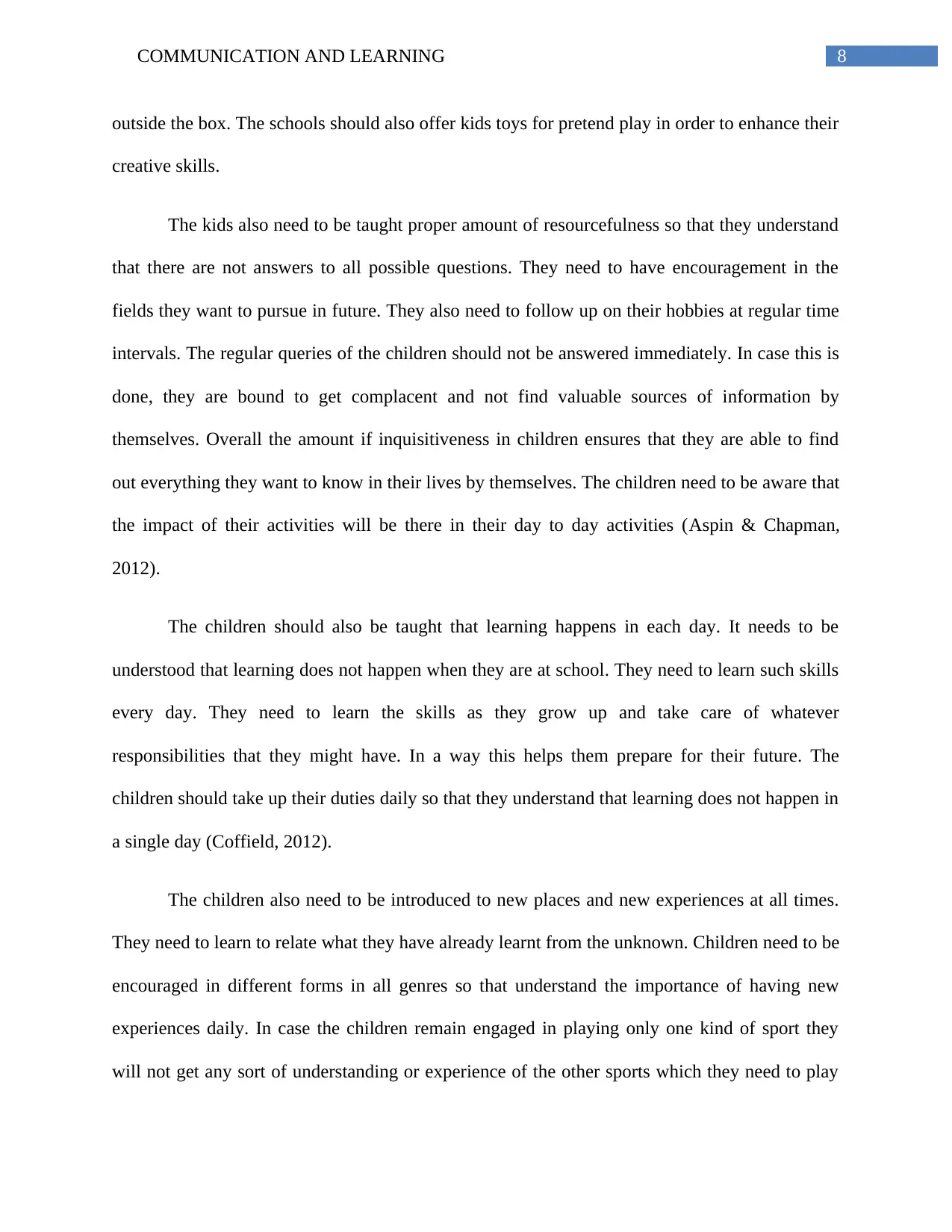
8COMMUNICATION AND LEARNING
outside the box. The schools should also offer kids toys for pretend play in order to enhance their
creative skills.
The kids also need to be taught proper amount of resourcefulness so that they understand
that there are not answers to all possible questions. They need to have encouragement in the
fields they want to pursue in future. They also need to follow up on their hobbies at regular time
intervals. The regular queries of the children should not be answered immediately. In case this is
done, they are bound to get complacent and not find valuable sources of information by
themselves. Overall the amount if inquisitiveness in children ensures that they are able to find
out everything they want to know in their lives by themselves. The children need to be aware that
the impact of their activities will be there in their day to day activities (Aspin & Chapman,
2012).
The children should also be taught that learning happens in each day. It needs to be
understood that learning does not happen when they are at school. They need to learn such skills
every day. They need to learn the skills as they grow up and take care of whatever
responsibilities that they might have. In a way this helps them prepare for their future. The
children should take up their duties daily so that they understand that learning does not happen in
a single day (Coffield, 2012).
The children also need to be introduced to new places and new experiences at all times.
They need to learn to relate what they have already learnt from the unknown. Children need to be
encouraged in different forms in all genres so that understand the importance of having new
experiences daily. In case the children remain engaged in playing only one kind of sport they
will not get any sort of understanding or experience of the other sports which they need to play
outside the box. The schools should also offer kids toys for pretend play in order to enhance their
creative skills.
The kids also need to be taught proper amount of resourcefulness so that they understand
that there are not answers to all possible questions. They need to have encouragement in the
fields they want to pursue in future. They also need to follow up on their hobbies at regular time
intervals. The regular queries of the children should not be answered immediately. In case this is
done, they are bound to get complacent and not find valuable sources of information by
themselves. Overall the amount if inquisitiveness in children ensures that they are able to find
out everything they want to know in their lives by themselves. The children need to be aware that
the impact of their activities will be there in their day to day activities (Aspin & Chapman,
2012).
The children should also be taught that learning happens in each day. It needs to be
understood that learning does not happen when they are at school. They need to learn such skills
every day. They need to learn the skills as they grow up and take care of whatever
responsibilities that they might have. In a way this helps them prepare for their future. The
children should take up their duties daily so that they understand that learning does not happen in
a single day (Coffield, 2012).
The children also need to be introduced to new places and new experiences at all times.
They need to learn to relate what they have already learnt from the unknown. Children need to be
encouraged in different forms in all genres so that understand the importance of having new
experiences daily. In case the children remain engaged in playing only one kind of sport they
will not get any sort of understanding or experience of the other sports which they need to play
⊘ This is a preview!⊘
Do you want full access?
Subscribe today to unlock all pages.

Trusted by 1+ million students worldwide
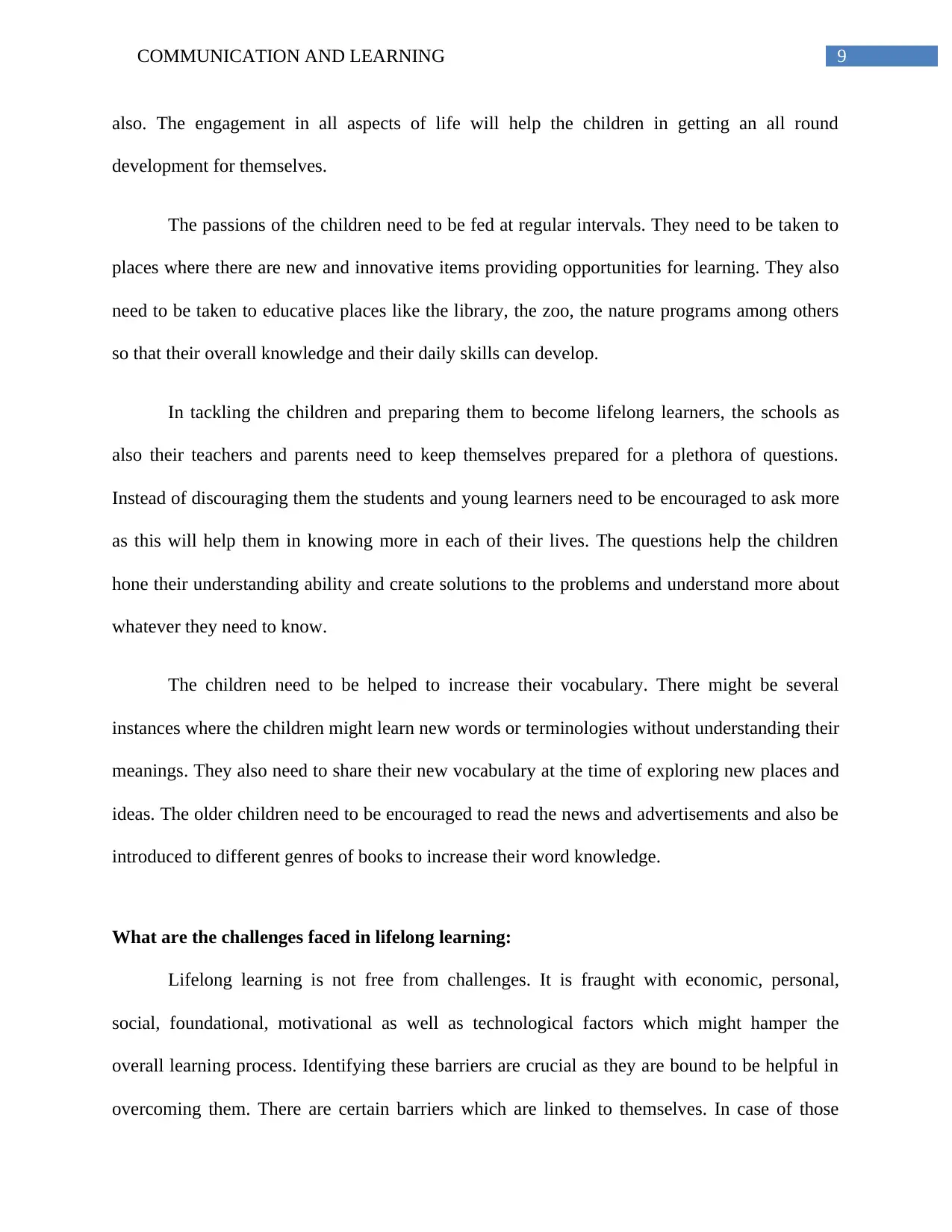
9COMMUNICATION AND LEARNING
also. The engagement in all aspects of life will help the children in getting an all round
development for themselves.
The passions of the children need to be fed at regular intervals. They need to be taken to
places where there are new and innovative items providing opportunities for learning. They also
need to be taken to educative places like the library, the zoo, the nature programs among others
so that their overall knowledge and their daily skills can develop.
In tackling the children and preparing them to become lifelong learners, the schools as
also their teachers and parents need to keep themselves prepared for a plethora of questions.
Instead of discouraging them the students and young learners need to be encouraged to ask more
as this will help them in knowing more in each of their lives. The questions help the children
hone their understanding ability and create solutions to the problems and understand more about
whatever they need to know.
The children need to be helped to increase their vocabulary. There might be several
instances where the children might learn new words or terminologies without understanding their
meanings. They also need to share their new vocabulary at the time of exploring new places and
ideas. The older children need to be encouraged to read the news and advertisements and also be
introduced to different genres of books to increase their word knowledge.
What are the challenges faced in lifelong learning:
Lifelong learning is not free from challenges. It is fraught with economic, personal,
social, foundational, motivational as well as technological factors which might hamper the
overall learning process. Identifying these barriers are crucial as they are bound to be helpful in
overcoming them. There are certain barriers which are linked to themselves. In case of those
also. The engagement in all aspects of life will help the children in getting an all round
development for themselves.
The passions of the children need to be fed at regular intervals. They need to be taken to
places where there are new and innovative items providing opportunities for learning. They also
need to be taken to educative places like the library, the zoo, the nature programs among others
so that their overall knowledge and their daily skills can develop.
In tackling the children and preparing them to become lifelong learners, the schools as
also their teachers and parents need to keep themselves prepared for a plethora of questions.
Instead of discouraging them the students and young learners need to be encouraged to ask more
as this will help them in knowing more in each of their lives. The questions help the children
hone their understanding ability and create solutions to the problems and understand more about
whatever they need to know.
The children need to be helped to increase their vocabulary. There might be several
instances where the children might learn new words or terminologies without understanding their
meanings. They also need to share their new vocabulary at the time of exploring new places and
ideas. The older children need to be encouraged to read the news and advertisements and also be
introduced to different genres of books to increase their word knowledge.
What are the challenges faced in lifelong learning:
Lifelong learning is not free from challenges. It is fraught with economic, personal,
social, foundational, motivational as well as technological factors which might hamper the
overall learning process. Identifying these barriers are crucial as they are bound to be helpful in
overcoming them. There are certain barriers which are linked to themselves. In case of those
Paraphrase This Document
Need a fresh take? Get an instant paraphrase of this document with our AI Paraphraser

10COMMUNICATION AND LEARNING
individuals who have stopped learning after their childhood, there are bound to be several
barriers which they might face in this particular regard. They might have attitudinal problems,
they might face problems in confidence after so many years, they might face problems at home
or the situations might not be fruitful enough for them to work well. The people who have again
taken the initiative of learning after a long time might face issue in learning with the younger
learners. They need to be able to create flexible, rich as well as interactive learning environments
(Ranieri, Manca & Fini, 2012).
There are certain barriers which are in the minds of the people. They do not need outer
help much to solve these kind of issues. What is needed is the careful understanding of their
mental powers and abilities which are needed to grasp the situations at all times. They need to
teach their minds not be prejudiced and focus on what is important at all times. Once the matters
of the mind are sorted, the barriers related to the thought processes of the learners can be cured.
It needs to be understood that the barriers to learning no matter whatever their nature, namely
structural, cultural or personal among others are resolvable and can be solved easily.
There are problems faced at home where proper among of encouragement to lifelong
learning is not given in several cases. The issue of globalization and the fast paced technological
advancement in the world are responsible for one of the barriers in the learning procedure as
people of earlier generations are not aware of these differences.
In certain cases where individuals are interested in continuing learning which might be of
technical or professional nature, despite receiving support from family, it is found that they
cannot enrol in courses due to financial issues in their homes (Thrun, 2012).
individuals who have stopped learning after their childhood, there are bound to be several
barriers which they might face in this particular regard. They might have attitudinal problems,
they might face problems in confidence after so many years, they might face problems at home
or the situations might not be fruitful enough for them to work well. The people who have again
taken the initiative of learning after a long time might face issue in learning with the younger
learners. They need to be able to create flexible, rich as well as interactive learning environments
(Ranieri, Manca & Fini, 2012).
There are certain barriers which are in the minds of the people. They do not need outer
help much to solve these kind of issues. What is needed is the careful understanding of their
mental powers and abilities which are needed to grasp the situations at all times. They need to
teach their minds not be prejudiced and focus on what is important at all times. Once the matters
of the mind are sorted, the barriers related to the thought processes of the learners can be cured.
It needs to be understood that the barriers to learning no matter whatever their nature, namely
structural, cultural or personal among others are resolvable and can be solved easily.
There are problems faced at home where proper among of encouragement to lifelong
learning is not given in several cases. The issue of globalization and the fast paced technological
advancement in the world are responsible for one of the barriers in the learning procedure as
people of earlier generations are not aware of these differences.
In certain cases where individuals are interested in continuing learning which might be of
technical or professional nature, despite receiving support from family, it is found that they
cannot enrol in courses due to financial issues in their homes (Thrun, 2012).
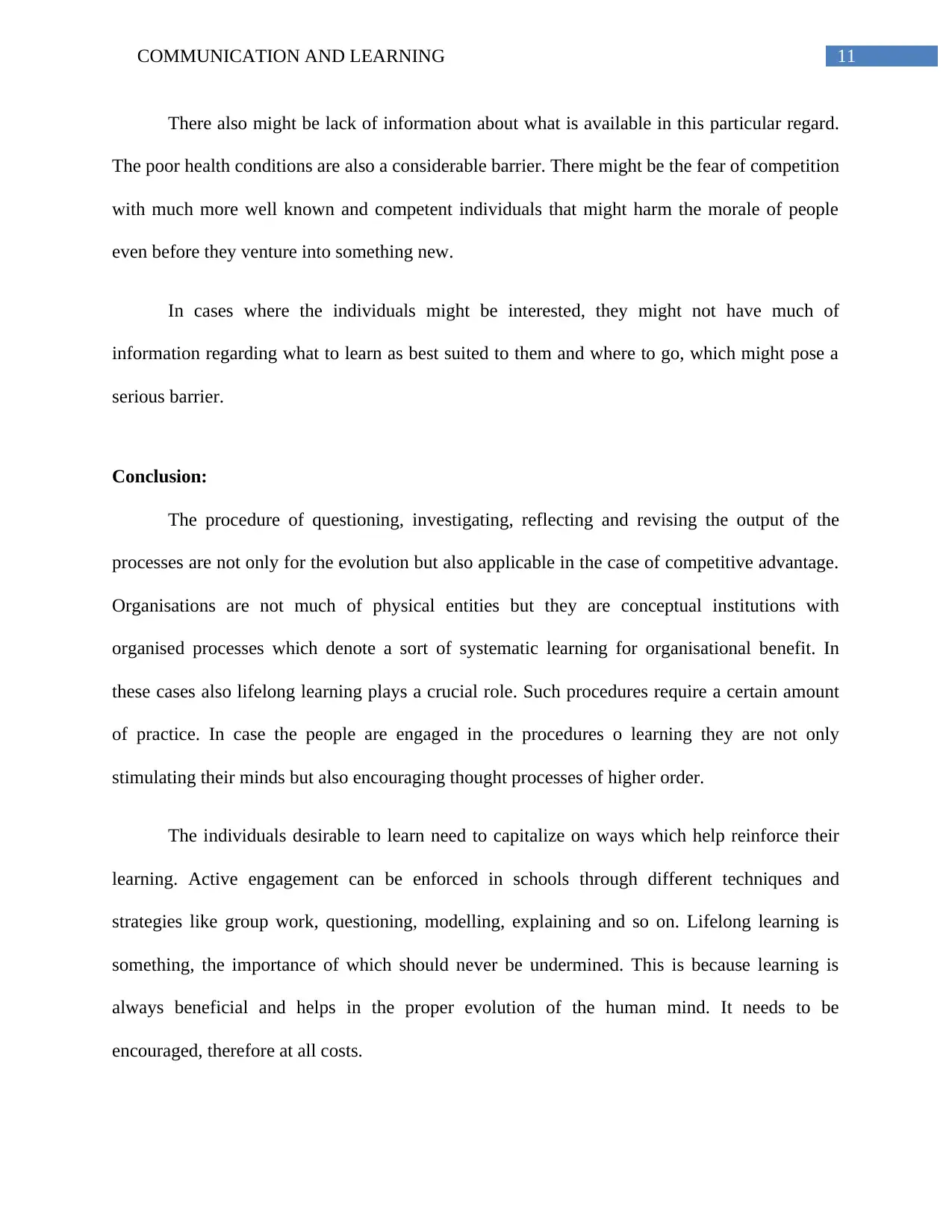
11COMMUNICATION AND LEARNING
There also might be lack of information about what is available in this particular regard.
The poor health conditions are also a considerable barrier. There might be the fear of competition
with much more well known and competent individuals that might harm the morale of people
even before they venture into something new.
In cases where the individuals might be interested, they might not have much of
information regarding what to learn as best suited to them and where to go, which might pose a
serious barrier.
Conclusion:
The procedure of questioning, investigating, reflecting and revising the output of the
processes are not only for the evolution but also applicable in the case of competitive advantage.
Organisations are not much of physical entities but they are conceptual institutions with
organised processes which denote a sort of systematic learning for organisational benefit. In
these cases also lifelong learning plays a crucial role. Such procedures require a certain amount
of practice. In case the people are engaged in the procedures o learning they are not only
stimulating their minds but also encouraging thought processes of higher order.
The individuals desirable to learn need to capitalize on ways which help reinforce their
learning. Active engagement can be enforced in schools through different techniques and
strategies like group work, questioning, modelling, explaining and so on. Lifelong learning is
something, the importance of which should never be undermined. This is because learning is
always beneficial and helps in the proper evolution of the human mind. It needs to be
encouraged, therefore at all costs.
There also might be lack of information about what is available in this particular regard.
The poor health conditions are also a considerable barrier. There might be the fear of competition
with much more well known and competent individuals that might harm the morale of people
even before they venture into something new.
In cases where the individuals might be interested, they might not have much of
information regarding what to learn as best suited to them and where to go, which might pose a
serious barrier.
Conclusion:
The procedure of questioning, investigating, reflecting and revising the output of the
processes are not only for the evolution but also applicable in the case of competitive advantage.
Organisations are not much of physical entities but they are conceptual institutions with
organised processes which denote a sort of systematic learning for organisational benefit. In
these cases also lifelong learning plays a crucial role. Such procedures require a certain amount
of practice. In case the people are engaged in the procedures o learning they are not only
stimulating their minds but also encouraging thought processes of higher order.
The individuals desirable to learn need to capitalize on ways which help reinforce their
learning. Active engagement can be enforced in schools through different techniques and
strategies like group work, questioning, modelling, explaining and so on. Lifelong learning is
something, the importance of which should never be undermined. This is because learning is
always beneficial and helps in the proper evolution of the human mind. It needs to be
encouraged, therefore at all costs.
⊘ This is a preview!⊘
Do you want full access?
Subscribe today to unlock all pages.

Trusted by 1+ million students worldwide
1 out of 14
Related Documents
Your All-in-One AI-Powered Toolkit for Academic Success.
+13062052269
info@desklib.com
Available 24*7 on WhatsApp / Email
![[object Object]](/_next/static/media/star-bottom.7253800d.svg)
Unlock your academic potential
Copyright © 2020–2025 A2Z Services. All Rights Reserved. Developed and managed by ZUCOL.





